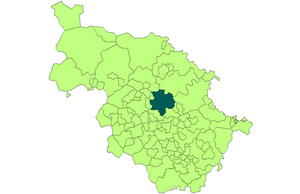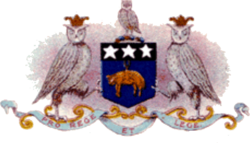Leeds Country Borough
| City of Leeds County Borough of Leeds |
|
|---|---|
 Leeds Town Hall |
|
 Leeds shown within the West Riding in 1971 |
|
| Area | |
| • 1911 | 21,593 acres (8,738 ha) |
| • 1931 | 38,105 acres (15,421 ha) |
| • 1961 | 40,612 acres (16,435 ha) |
| Population | |
| • 1911 | 445,550 |
| • 1931 | 482,809 |
| • 1961 | 510,676 |
| Density | |
| • 1911 | 21/acre |
| • 1931 | 13/acre |
| • 1961 | 13/acre |
| History | |
| • Origin | Leeds ancient borough |
| • Created | 1836 |
| • Abolished | 1974 |
| • Succeeded by | City of Leeds (metropolitan district) |
| Status |
Municipal borough (1835–1889) County borough (1889–1974) City (1893–1974) |
| • HQ | Leeds |
| • Motto | PRO REGE ET LEGE |
 Coat of arms in use until 1921 |
|
The County Borough of Leeds, and its predecessor, the Municipal Borough of Leeds, was a local government district in the West Riding of Yorkshire, England, from 1835 to 1974. Its origin was the ancient borough of Leeds, which was reformed by the Municipal Corporations Act 1835. In 1889, when West Riding County Council was formed, Leeds became a county borough outside the administrative county of the West Riding; and in 1893 the borough gained city status. The borough was extended a number of times, expanding from 21,593 acres (8,738 ha) in 1911 to 40,612 acres (16,435 ha) in 1961; adding in stages the former area of Roundhay, Seacroft, Shadwell and Middleton parishes and gaining other parts of adjacent districts. In 1971 Leeds was the fifth largest county borough by population in England. The county borough was abolished in 1974 and replaced with the larger City of Leeds, a metropolitan district of West Yorkshire.
The Borough of Leeds was created in 1207, when Maurice Paynel, Lord of the Manor, granted a charter to the inhabitants of the town of Leeds. They were created "burgesses", and were given the right to hold half an acre of land, trade as they liked, and transport their goods by land or water, subject to tolls and restrictions paid to the manor. The only officer of the borough was a praetor, appointed annually at the Feast of Pentecost by the Lord of the Borough. The praetor had the duty of administering justice and collecting fines and other revenues. The borough formed only a small area adjacent to a crossing of the River Aire, between the old settlement centred on Leeds Parish Church to the east and the manor house and mills to the west. The borough consisted of a single street with approximately thirty burgage plots. By the seventeenth century the title of praetor had been abandoned in favour of the more customary "bailiff", but otherwise the government of the town remained in the form introduced in the thirteenth century. An enquiry into the administration of local charities in 1620 disclosed that many of the funds were diverted by the bailiff for his private use. This, and other irregularities, led the inhabitants of Leeds to petition Charles I for a charter of incorporation.
...
Wikipedia
